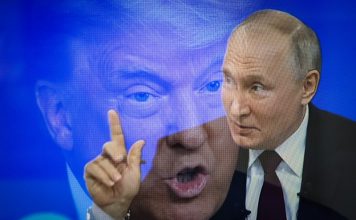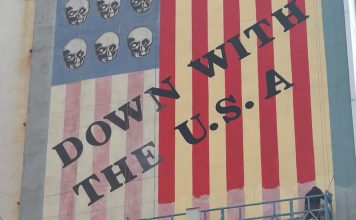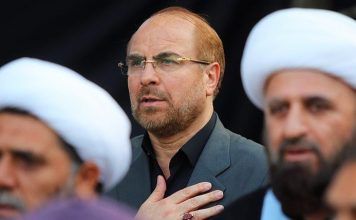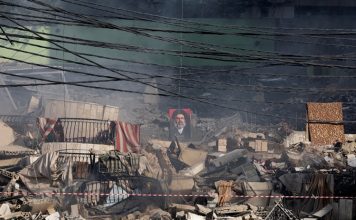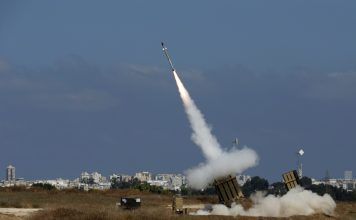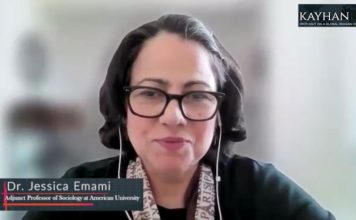Kayhan Life Staff
The United States and Albania held an informal U.N. Security Council meeting on Wednesday, putting a spotlight on protests in Iran sparked by the death of a young woman, Mahsa Amini. in police custody. The meeting aimed to look for ways to promote credible, independent investigations into Iranian human rights abuses.
Iranian Nobel Peace Prize laureate Shirin Ebadi and Iranian-born actress and activist Nazanin Boniadi both spoke at the meeting.
[aesop_image img=”https://kayhanlife.com/wp-content/uploads/2022/11/2022-11-02T190731Z_1956613550_RC2UDX903QTW_RTRMADP_3_IRAN-WOMEN-UN.jpg” panorama=”off” credit=”REUTERS/Andrew Kelly” align=”center” lightbox=”off” captionsrc=”custom” caption=”Actor and activist Nazanin Boniadi delivers remarks during a UN Security Council Arria-formula meeting focused on the ongoing protests in Iran, hosted by the United States and Albania, at the United Nations in Manhattan, New York City, U.S., November 2, 2022. ” captionposition=”left” revealfx=”off” overlay_revealfx=”off”]
Below is the spoken appeal of Ms Boniadi.
And following the powerful remarks of Special Rapporteur Rahman and Dr. Ebadi, I’d like to start by talking a little about the current crisis in Iran, then debunk a couple of myths and finally offer a way forward.
Two days ago I received a message from a relative of a prominent political prisoner in Iran to avoid naming to protect them from retaliation by the Islamic Republic authorities. It reads, I asked the United Nations not to be indifferent to the crimes against humanity inside Iran, because they’re killing our children. Protesting is the right of every nation. But the Islamic Republic kills protesters with war bullets, as the United Nations not to remain silent because the lives of our political prisoners are in danger. And many have lost their health or died under torture.
I’ve been working in the Iran human rights advocacy space for 14 years now. Never during that time have I witnessed such widespread and committed opposition to the Islamic Islamic Republic. regime, as there is in Iran today.
While Iran has become accustomed to mass protests nearly once every decade, neither the student protests of 1999 nor the green movement of 2009, or even the most more recent November 2019 protests, compare and fervour or magnitude to the current protests, in which for the first time since the inception of a theocracy in 1979, people are not only openly opposing 83 year old Supreme Leader Ali harmony, which they started to do in 2017, but are actively fighting back to defend themselves against the security forces and tearing down billboards and burning pictures of the founder of the Islamic Republic, Ayatollah Khomeini.
As always, due to the lack of transparency the number of protesters killed, including women and children are likely to be much higher than reports suggest. They’ve been killed with batons to the head and bullets to the neck, even as they ran for their lives.
But the most unprecedented part of these protests is that they have been female led the murder in custody of the 22 year old Kurdish Iranian woman masala Xena ammini arrested for inappropriate hijab was the powder keg moment that ignited this most recent uprising. Women have taken to the streets and are not only removing and waving their head scarves, but setting them ablaze and cutting their hair in protest.
Despite knowing that they will be arrested and sent to psychological reeducation centres, beaten, raped and even killed. Young school girls are removing their mandatory head coverings and chanting We don’t want an Islamic Republic.
The movements slogan woman life freedom is a declaration of opposition to a regime which has built itself on being anti woman pro martyrdom and repressive.
To be clear this uprising is not just about draconian dress codes. However, the compulsory hijab has become the most visible symbol of the subjugation of Iranian women.
Now, Iranian men and women stand shoulder to shoulder against the Islamic Republic’s gender apartheid regime that has maintained its power not only through the segregation and oppression of women in Iran, but denial of all Iranians from freedom of expression, association and assembly, as well as fair trials and due process.
Make no mistake about it. The Islamic Republic is a totalitarian system that uses forced confessions and torture against its own citizens to stifle all dissent. According to the World Economic Forum’s 2022 Global Gender Gap Report Iran ranks 140/3 of 146 countries the Islamic Republic exemplifies why countries with the most discriminatory laws and attitudes towards women tend to also experience the greatest turmoil, which in turn compromises international peace and security.
This brings us to the first myth, which has sadly been perpetuated not only by representatives of the regime in Iran, but also by global pundits. And that’s the myth. The compulsory hijab is a cultural issue that we shouldn’t interfere with.
But you don’t need to subjugate people into observing cultural norms, where school girls are defined a lifetime of indoctrination by rising up in classrooms, and people are taking to the streets and 10s of in their 10s of 1000s. To protest something despite the risk of death at the hands of the authorities, you can safely assume that’s not part of their culture.
Coercion that violates human rights has no place in any culture and Iranians are risking everything for the world to understand this. Another myth is that this regime is reformable.
However, the 43 year case study of the Islamic Republic has proven otherwise. The Supreme Leader has during this time consolidated all levels of coercive state power. And Iranians and the world have repeatedly been hoodwinked to think that presidential elections, which have never been free or fair, would make a difference for them. But elections in Iran, a theatre, the rise of the presidency of Ebrahim Raisi, who has been a pillar of the oppressive state implicated in crimes against humanity and his leadership harkens back to 1980s.
Iran is proof enough that a culture of impunity reigns supreme in Iran, and the theocracy is impervious to reform.
I firmly believe the future of Iran can only be written by its own people on its own streets. But no country can go into loan and its pursuit of freedom and self determination.
This body has an important role to play in assisting assisting nations in crisis because the Islamic Republic isn’t just a threat to its own people. Its human rights abuses have become one of its primary exports.
The catalogue of abuses by the regime in Iran and around the world is well documented.
Throughout its history, the Islamic Republic regime has taken foreign hostages to use as political bargaining chips, and it’s intimidated, abducted and assassinated. Dozens of dissidents beyond its borders, including recent attention on the lives of prominent writers and activists just miles away from where we’re currently gathered
The potential for the current protests to transform Iran from theocracy to representative government could be a , geopolitical game changer, and the single most key most important key to bringing about stability in the Middle East.
That’s why I believe and building global unity and regional capacity against the Islamic Republic’s crimes under international law, including human rights abuses, that’s what the Iranian people want from us, and to stop turning a blind eye to their suffering in order to fulfil our own political objectives.
For decades, we’ve only responded to the symptoms of the Islamic Republic’s hostile activities with a focus on countering Iran’s nuclear ambitions and regional aggression.
But in order to address the cause, we must commit ourselves to intelligently supporting the Iranian people’s democratic aspirations. What does that look like?
We must stand united in fighting corruption and promoting respect for human rights. And the current crisis in Iran calls for us to urgently support the establishment of an international independent investigative mechanism on the human rights abuses in Iran, because there are no avenues for justice domestically in the country.
At a time when the Islamic Republic state security forces are once again, using disproportionate violence on protesters. It’s crucial that we document these human rights violations and atrocity crimes and have mechanisms in place to hold those responsible, accountable.
It’s only with this level of international coordination and support for accountability and justice for the Iranian people that we can address the Islamic Republic itself as the cause of our nuclear and geopolitical concerns.
But one thing is clear. human rights abuses at this scale are a symptom of a deep political malaise and a government considered illegitimate by its own people. Human rights are intricately bound with respect for the rule of law, and there can be no good governance in the long run without the rule of law.
Good and law abiding governance not only make for better regional neighbours but also cooperative members of the international community in Iran that is more respected, respectful of and representative of its citizen. Citizens will help this august body achieve its central mission, the maintenance of international peace and security.
While the Islamic Republic doesn’t really represent Iran’s 2500 years of rich history and culture, I’ll leave you with something that does a poem banni are done by the 13th century Persian poet Saadi which was also inscribed on the United Nations building entrance.
Human beings are a member of a whole in creation of one essence.
And so if one member is afflicted with pain, other members uneasy remain.
If you have no sympathy for human pain, the name of human you cannot retain
The international community should want what the courageous demonstrators in Iran want. It’s time for us to stop abetting the Islamic Republic of Iran and start supporting the freedom loving people of Iran. Thank you.

